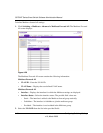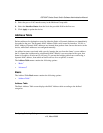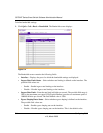
5-1
v1.0, March 2008
Chapter 5
Configuring QoS
Configuring the Basic and Advanced QoS Settings
The navigation pane at the top of the web browser interface contains a QoS tab that enables you to
manage your GS700AT Series Smart Switch with features under the following main heading:
• “CoS”
The description that follows in this chapter describes configuring and managing QoS settings in
the GS700AT Series Smart Switch.
CoS
Quality of Service (QoS) provides the ability to implement QoS and priority queuing within a
network. For example, certain types of traffic that require minimal delay, such as Voice, Video, and
real-time traffic can be assigned to a high priority queue, while other traffic can be assigned to a
lower priority queue. The result is an improved traffic flow for traffic with high demand. QoS is
defined by:
• Classification – Specifies which packet fields are matched to specific values. All packets
matching the user-defined specifications are classified together.
• Action – Defines traffic management where packet forwarding is based on packet information
and packet field values such as VLAN Priority Tag (VPT) and DiffServ Code Point (DSCP).
After packets are assigned to a specific egress queue, CoS services can be assigned to the queue.
Egress queues are configured with a scheduling scheme by one of the following methods:
• Strict Priority – Ensures that time-sensitive applications are always forwarded. Strict Priority
(SP) allows the prioritization of mission-critical, time-sensitive traffic over less time-sensitive
applications. For example, under SP, voice over IP (VoIP) traffic can be prioritized so that it is
forwarded before FTP or email (SMTP) traffic.


















